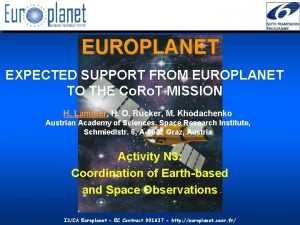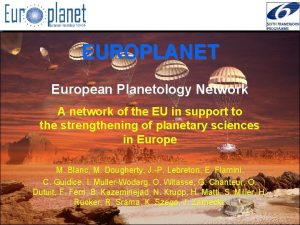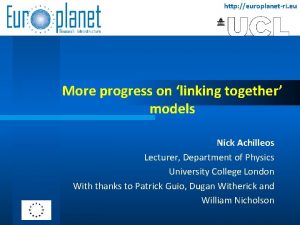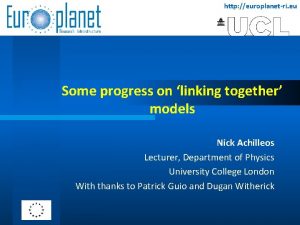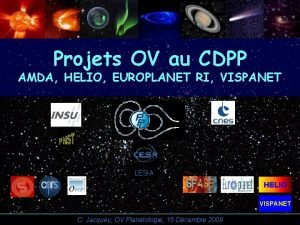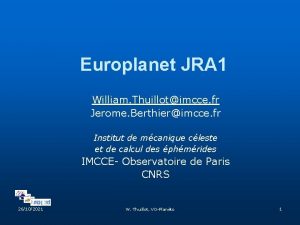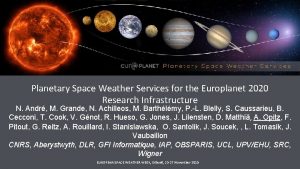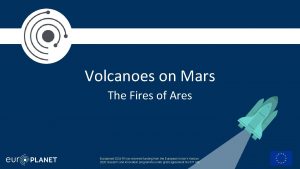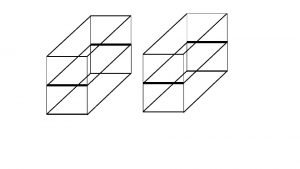EUROPLANET RI http europlanetri eu A NETWORK FOR















- Slides: 15

EUROPLANET RI http: //europlanet-ri. eu A NETWORK FOR ALL PLANETARY SCIENTISTS A SERVICE TO THE COMMUNITY Manuel Grande Scientific Dissemination Coordinator EC GRANT AGREEMENT NO 228319

A UNIQUE OPPORTUNITY!

Our responsibility and our goal: Provide support to the optimal use of data from past and present space missions by the broadest possible science community Provide support to the preparation of future planetary missions : – – Earth-based preparatory observations, laboratory studies, R and D on advanced instrumentation and exploration technologies, theory and modelling, … Bridge the gap between past/present space missions and those for the next generation 3

SCIENTIFIC STRUCTURE Science Drivers Small bodies Terrestrial & origin "Magnetics planets Exoplanets & worlds & other " plan Giant planet systems of the solar comparative system The Sun planetology – planets connection systems Laboratory facilities field analogues Comp. modelling & data analysis facilities Data bases Space and Earth-based Observational facilities Dedicated Services Research Infrastructures 4

EPSC is the platform of the Europlanet Research infrastructure It’s a self standing meeting organised by Copernicus, where Europlanet does its business 80 sessions (70 2011) 1900 Abstracts ? attendees

Technology Foresight – Planetary Detectors Tue PM Press office (Anita Heward, anitaheward@btinternet. com

TECHNOLOGY FORESIGHT WORKSHOPS The European planetary community lacks a clear path for identifying the technology needed for future planetary exploration. where European instrument capabilities can be married to planetary exploration science requirements. We organise a series of workshops aimed at identifying roadmaps for key technologies

TECHNOLOGY FORESIGHT WORKSHOPS Previous: Planetary Robotics Planetary Cartography Detectors for Planetary Science

MX AND CLUSTER RAPID

X-RAY SPECTROMETER ON SMART-1 AND CHANDRAYAAN -1 1 The Sun shines on the Moon (in X rays) 2 The Moon fluoresces 3 Each X-ray energy indicates unambiguously the abundance of a particular element in the surface 4 CIXS used two new technologies to detect these Xrays Sun Shines in X-rays So we could measure what the Moon is made of

C 1 XS

TECHNOLOGY FORESIGHT WORKSHOPS Need to match up science requirements with available technologies - Galileo: But mustn’t forget that the science is primary

QUESTIONS What are the major science drivers for the next 20 years? (i. e. from now to 2030) How will science instrumentation change over the next 20 years? What methods will we need to address these science challenges (Resolution, radiation Hardness, readout speed etc. )? What are the priority robotic technologies that we must invest in now to meet these future science challenges? What are the priority constituent technologies that we must invest in now to meet these future science challenges? (e. g. materials technology, computing, etc. ) Are there nearer term technologies that we can significantly improve, and how? What will the planetary detector technology road-map look like from now to 2030?

OUTPUTS

OUTPUTS
 Http //mbs.meb.gov.tr/ http //www.alantercihleri.com
Http //mbs.meb.gov.tr/ http //www.alantercihleri.com Siat.ung.ac.id krs
Siat.ung.ac.id krs Kontinuitetshantering
Kontinuitetshantering Typiska drag för en novell
Typiska drag för en novell Tack för att ni lyssnade bild
Tack för att ni lyssnade bild Vad står k.r.å.k.a.n för
Vad står k.r.å.k.a.n för Varför kallas perioden 1918-1939 för mellankrigstiden?
Varför kallas perioden 1918-1939 för mellankrigstiden? En lathund för arbete med kontinuitetshantering
En lathund för arbete med kontinuitetshantering Kassaregister ideell förening
Kassaregister ideell förening Personlig tidbok fylla i
Personlig tidbok fylla i Sura för anatom
Sura för anatom Förklara densitet för barn
Förklara densitet för barn Datorkunskap för nybörjare
Datorkunskap för nybörjare Boverket ka
Boverket ka Debattartikel struktur
Debattartikel struktur Autokratiskt ledarskap
Autokratiskt ledarskap
















